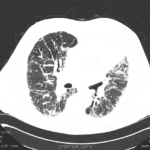In June of 2023 Fibrogen announced the results of the ZEPHYRUS-1 clinical trial of Pamrevlumab in IPF. Pamrevlumab entered phase 3 with much anticipation. Phase 2 work suggested that the molecule had a high chance of success. Unfortunately, in the phase 3 study which included 356 subjects, Pamrevlumab was not effective at preserving lung function. As a result, Fibrogen … [Read more...]
New Drugs Moving Forward for IPF
BI 1015550 The past few months have brought very exciting news for IPF patients. A novel drug being developed by Boehringer Ingelheim (BI 1015550) showed positive results in a phase 2 study. This new medication blocks the phosphodiesterase 4B receptor. Blockade of this receptor has shown promise in animal models by causing reduced inflammation and … [Read more...]
Pulmonary Fibrosis and Pulmonary Hypertension – a New Treatment Option
United Therapeutics announced positive results of their study looking at the role of Tyvaso in patients with pulmonary fibrosis and pulmonary hypertension. This is a landmark event. No study to date has shown positive results in this population. Patients with interstitial lung disease (broad category of lung disorders involving scarring of the … [Read more...]
A New Paradigm in the Treatment of Pulmonary Fibrosis
The standard approach to treating pulmonary fibrosis involves first determining if the pattern is typical of IPF or if the pattern is not typical. This assessment is primarily based on high resolution CT characteristics in combination with patient characteristics (age greater than 50, cough and shortness of breath, crackles and clubbing on lung exam). Patients … [Read more...]
Scleroderma Associated Pulmonary Fibrosis: A New Study
Idiopathic pulmonary fibrosis (IPF) is just one of many types of pulmonary fibrosis. In patients with IPF, no other cause can be found and the disease has a typical radiographic pattern and when biopsied has a characteristic appearance under the microscope. Scleroderma is a connective tissue disease characterized by skin thickening, esophageal … [Read more...]




